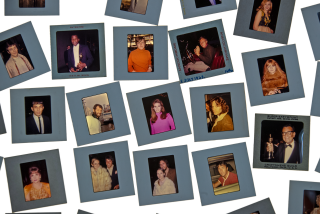From ‘angel’ to ‘monster’
- Share via
If viewers today remember the work of actor Jackie Coogan (who died in 1984 at the age of 69), odds are that they know him as Uncle Fester, the bald and ghoulish-looking cast member of the 1960s TV series “The Addams Family.” Few but film scholars recall Coogan’s huge success as an angel-faced child performer in the silent-movie era, star of such films as “Peck’s Bad Boy” and “Oliver Twist” (with Lon Chaney as Fagin). At the age of 9, Jackie Coogan was the No. 1 box-office draw in the country, ahead of Douglas Fairbanks and Rudolph Valentino.
An immediate success when he appeared opposite Charlie Chaplin in the feature “The Kid,” Coogan seemed “both waif and wonder child in one,” writes Diana Serra Cary, in this first biography of America’s first full-fledged child movie star. “He was an anomaly -- an adult film actor housed in the small body of an adorable and winsome child.” Little Jackie’s performing skills and natural charm moved colleagues and film critics alike to extremes of verbal rapture. “Just to be in his presence is to feel inspired,” said Chaplin. Writer Herbert Howe stated: “Jackie Coogan is a masterpiece of life.”
As his fame grew throughout the ‘20s, “Jackie Coogan was hailed as a genius, a ‘spiritual leader,’ a golden boy whose worldwide stardom assured him a future of knowledge, wealth, and renown,” Cary writes. “He was ballyhooed as a marvel of humankind, somewhere between the divinely wise Boy Jesus in the temple and the wildly popular, young, party-going Prince of Wales. Magnified a hundred times on the screen, Jackie’s image was an icon recognized in every country in the world.”
Unable to venture onto the streets of his hometown, Los Angeles (or any other city), without being mobbed, Jackie Coogan grew up in a rarefied environment, traveling in his own private railroad car, discussing “Hamlet” with Broadway producer David Belasco, sitting at the piano with Ignace Jan Paderewski, chatting with Sir Arthur Conan Doyle. “Other boys went to see Babe Ruth,” Coogan recalled later in life. “But Babe Ruth came to see me.”
When Jackie Coogan did go out to meet his public, it was on a memorable scale. In 1924, he undertook a five-week American and European charity fundraising tour on behalf of 70,000 orphans of the Near East. Crowds in the hundreds of thousands, from Boston and Brooklyn to Paris and London, thronged to greet “the boy king” on his modern-day “children’s crusade.” At the climax of his tour, in Athens, Coogan delivered more than a million dollars’ worth of relief cargo to the Greek government and was decorated with the Silver Cross of the Order of St. George.
Young Coogan’s charmed life seemed like a fairy tale, but in time the tale turned Grimm. Coogan grew too old for childhood roles. A squabble with Louis B. Mayer got him blackballed from major studios. Most devastating of all, “the Millionaire Kid” -- who had made enormous sums not only from acting but also through endorsements of scores of products, from lunch boxes to a line of boys’ clothing to Jackie Coogan dolls -- was broke at 21, robbed of the fortune promised him by his parents and financial guardians. The enchanted childhood had come to a bitter end.
Coogan served with valor as a glider pilot in World War II, and, despite often heavy drinking, he continued to work as a character actor throughout his life, eventually gaining a second measure of fame as “The Addams Family’s” grotesque Uncle Fester, but at a cost. Cary recounts a story told by Coogan’s daughter: “One day he came home from shooting an episode, crying -- and sober. He said, ‘I used to be the most beautiful child in the world and now I’m a hideous monster!’ -- It hit him.”
Jackie Coogan’s saga, Cary writes, is “a true-life tale of selfishness, greed, and betrayal rare even in what is often said to be hard-hearted Hollywood.” What makes her book especially noteworthy is the informed and compelling manner in which she tells that dramatic tale. Author of three previous acclaimed works of film-town history (including “The Hollywood Posse” and “Hollywood’s Children”), Cary brings to vibrant life not only the distant world of the silent-screen 1920s but also the earlier, tawdrier world of vaudeville.
Jackie was born into that world in 1914, first child of “a mother who had trod the boards as Baby Lillian and a father to whom flawless soft-shoe dancing ranked as one of Western civilization’s major contributions.” By age 4, “Junior” Coogan was a showstopping part of his parents’ act, reciting a tear-jerking monologue before dancing a wicked “shimmy shewobble.” When the Coogans played the downtown Orpheum in dull old L.A., where often “the rubes of Los Angeles ... ‘sat on their hands like a Kansas City supper show,’ ” Jackie was spied by Chaplin, who soon put him in front of the cameras in his studio at Sunset and La Brea. Before long, Jackie’s face was famous in 50 nations.
Cary is especially good at conveying Coogan’s early appeal and placing it in its social context. She agrees with Chaplin that “part of the strong universal response to Jackie’s waiflike image” was that in the aftermath of World War I “Jackie provided something the world needed, a lost child to take to its heart and comfort.” She is also fine in describing Hollywood in the ‘20s, a scene she has good reason to know. In the years when Jackie Coogan was captivating moviegoers, the author, three years younger, had also won the favor of film fans. As “Baby Peggy” Montgomery, starting at not quite age 2, she starred in more than 100 two-reel comedies and five feature films. Cary and Coogan were childhood colleagues: “I visited his movie sets, I attended Hollywood premieres with him, and his parents were often guests in our home.” Cary, then, is an occasional first-person presence in these pages, providing sharp, magic-mirror glimpses of key moments in Coogan’s life and career.
Also like Coogan, “Baby Peggy” made millions that were taken and/or squandered by grown-ups. Her brief but excruciating account of her own adolescent ordeal -- keeping up a false front of success while trying to revive her career as family breadwinner -- foreshadows Coogan’s eye-opening, headline-making 1938 lawsuit against those who had kept his earnings. And the two of them were hardly the only victims: Even as Coogan’s suit progressed, two other Hollywood children, Edith Fellows and Freddie Bartholomew, were also in court, attempting to keep their hard-earned wages out of the hands of eager relatives. Such lawsuits continue into the present, Cary points out in a final chapter, mentioning such contemporary figures as Gary Coleman and Macaulay Culkin.
The most lasting legacy, it would seem, of Jackie Coogan, one-time “golden boy” and “masterpiece of life,” is the so-called Coogan Law, passed by the California Legislature in the wake of Coogan’s travails, to help safeguard the wages of future child performers. Soon, according to Cary, a revised and tougher version of the Coogan Law will become effective nationwide, thanks in large part, she says, to the efforts of an advocacy group headed by former ‘60s child performer Paul Petersen. “It was yesterday’s child actors who came to the rescue of today’s child stars,” Cary writes, “and Jackie’s name was prominent among them.”
And now Jackie Coogan’s story has been rescued, presented with great skill and pathos by another victim and survivor of the child-star campaigns -- one who was tough and smart and lucky enough to have lived to tell the tale.
More to Read
Only good movies
Get the Indie Focus newsletter, Mark Olsen's weekly guide to the world of cinema.
You may occasionally receive promotional content from the Los Angeles Times.










